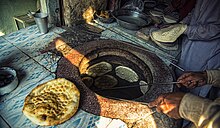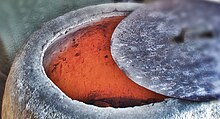Tandoor


Atandoor(/tænˈdʊər/or/tɑːnˈdʊər/) is a large vase-shapedoven,usually made of clay. Since antiquity, tandoors have been used to bake unleavenedflatbreads,such asrotiandnaan,as well as to roast meat. The tandoor is predominantly used inWestern Asian,Central Asian,South Asian,andHorn of Africancuisines.
The roots of the tandoor can be traced back over 5,000 years to the ancientIndus Valley Civilization,one of the oldest known civilizations. The standard heating element of a tandoor is an internalcharcoalor wood fire, which cooks food with direct heat and smoke. Tandoors can be fully above ground, or partially buried below ground, often reaching over a meter in height/depth. Temperatures in a tandoor can reach 480 °C (900 °F; 750 K), and they are routinely kept lit for extended periods. Therefore, traditional tandoors are usually found in restaurant kitchens. Modern tandoors are often made of metal. Variations, such as tandoors with gas or electric heating elements, are more common for at-home use.
Etymology
[edit]
The English word comes from theHindustanitandūr,which came from Persiantanūr(تَنور) and ultimately from theAkkadianwordtinūru(𒋾𒂟), which consists of the partstin'mud'andnuro/nura'fire'and is mentioned as early as in the AkkadianEpic of Gilgamesh,cf. orAvestantanûraandMiddle Persiantanûr.InSanskrit,the tandoor was referred to askandu.[1][2]
Words related and similar totandoorare used in various languages, for example theDari Persianwordstandūrandtanūr,Arabictannūr(تنّور),Armeniant’onir(Թոնիր),Assyriantanūra(ܬܢܘܪܐ),Azerbaijanitəndir,Georgiantone(თონე),Hebrewtanúr(תנור),Kyrgyztandyr(тандыр),Kazakhtandyr(тандыр),PashtoTanoor (تنور) and Taneer (تانير),Kurdishtenûr, tendûr,Tattənur,Tajiktanur(танур),Turkishtandır,Turkmentamdyr,Uzbektandir,Lugandattanuulu,andSomalitinaar.
Operation
[edit]
The first time a tandoor is used, the temperature must be gradually increased to condition the oven's interior. This step is crucial in ensuring the longevity of the tandoor. Conditioning can be done by starting a very small fire and slowly adding fuel to increase the amount of heat inside the tandoor gradually. Hairline cracks might form during conditioning; this is normal and will not interfere with the performance of the tandoor oven. When the oven cools off, the hairline cracks will barely be noticeable. They are essential in allowing the clay body of the tandoor to breathe (thermal expansion and contraction). The slower the temperature inside the tandoor increases during its first use, the fewer hairline cracks will develop.[3]
Types
[edit]Arab world: tannour / tannur
[edit]Persianate world and Southern Asia
[edit]Afghan tandoor
[edit]The Afghan tandoor sits above the ground and is made of bricks.[citation needed]
Punjabi tandoor
[edit]
ThePunjabi tandoorfromSouth Asiais traditionally made of clay and is a bell-shaped oven, which can either be set into the earth or rest above the ground and is fired with wood or charcoal, reaching temperatures of about 480 °C (900 °F; 750 K).[4]Tandoor cooking is a traditional aspect ofPunjabi cuisinein undividedPunjab.[5]
InIndiaandPakistan,tandoori cooking was traditionally associated with thePunjab,[6]as Punjabis embraced the tandoor on a regional level,[7]and became popular in the mainstream after the 1947 partition when Punjabi Sikhs and Hindus resettled in places such as Delhi.[8]In rural Punjab, it was common to have communal tandoors.[5] Some villages[9]still have a communal tandoor, a common sight before 1947.[10]
Armenian tonir
[edit]
In ancient times, thetonirwas worshiped by the Armenians as a symbol of the sun in the ground. Armenians made tonirs resembling the setting sun "going into the ground" (the Sun being the main deity). The underground tonir, made of clay, is one of the first tools in Armenian cuisine as an oven and thermal treatment tool. Armenians are said to have originated underground tonirs.[11][unreliable source?]
Azerbaijani tandir
[edit]
Inancient times,people used it to cook bread and various dishes.[12]
Tandir bread (təndir çörəyi,tandoori bread) is a widespread bread type inAzerbaijan.Tandir bread is baked from the heat of the tandir's walls, which ensures very fast baking.[13][14]
One of the world's biggest tandoors was built in Azerbaijan's southern city ofAstarain 2015. The height of the tandoor is 6.5 m (21 feet) and the diameter is 12 m (39 feet). The tandoor consists of 3 parts.[15]
Turkmen tamdyr
[edit]
The baking of a traditional, white bread calledçörekinTurkmenis an ancient and honored culinaryritualinTurkmenistan.It is made in the traditional clay oven, known astamdyrin Turkmenistan.[16]

MostTurkmenfamilies living in the rural area have tamdyrs in their households. Occasionally, housewives get together and bakeçörekfor several families. One of the most famous kinds ofçörekbaked in the Turkmen tamdyr isetli çörek(bread with meat), made duringtraditional holidays.Turkmens bake not only bread in the tamdyr but also several dishes, the most famous of which issomsa(an independent dish, similar to a pie, of any shape with a filling, usually beef). Variousspicescan be added to the Turkmen bread:cumin,cinnamon,olives,mustard,sunflower seedsand other flavoring ingredients.[17]To prepare tamdyr for baking; first, fire is made directly inside the tamdyr, usually using dried cotton stalks. The bread-maker then watches the color of the tamdyr's inner walls. When they turn white, the ashes are shoveled into the center of the tamdyr, and the lower ash-pit is closed.[16]
The bread must be thrown into the oven carefully but deftly so that it does not lose shape and neatly sticks to the wall.[17]
Dishes
[edit]

A tandoor may be used to bake many different types of flatbread. Some of the most common arelavash,tandoori roti,tandoori naan,tandoori lacchaparatha,missi roti,laffa,and tandoorikulcha.
Peshawari Kharare roasted cashews and cottage cheese paste marinated in spiced thick cream grilled in a tandoor.
Balochs and aloosare potatoes stuffed with cottage cheese, vegetables, and cashew nuts, roasted in a tandoor.
Tandoori chickenis a roasted chickendelicacythat originated inPunjabregion of South Asia.[18][19]The chicken is marinated in yogurt seasoned withgaram masala,garlic,ginger,cumin,cayenne pepper,and other spices depending on the recipe. In hot versions of the dish, cayenne, red chili powder, or other spices give the typical red color; in milder versions,food coloringis used.[20]Turmericproduces a yellow-orange color. It is traditionally cooked at high temperatures in a tandoor but can also be prepared on a traditional grill.
Chicken tikkais a dish fromMughlai cuisinethat originated inPunjabregion. It is made by grilling small pieces of boneless chicken which have beenmarinatedinspicesandyogurt.It is traditionally cooked on skewers in a tandoor and is usually boneless. It is normally served and eaten with a greencorianderchutneyor used in preparing the currychickentikka masala.
Tangdi kabab,a popular snack incuisine from the Indian subcontinent,is made by marinating chicken drumsticks and placing them in a tandoor. Various freshly ground spices are added to the yogurt to form a marinade for the chicken. Traditionally, the marinaded chicken is given 12 hours at the least. When prepared, the drumsticks are usually garnished with mint leaves and served with laccha (finely sliced half moons, with a squeeze of lemon and a pinch of salt) onions.
Samosais a stuffed snack consisting of a fried or baked triangular, semilunar, or tetrahedral pastry shell with a savory filling, which may include spiced potatoes, onions, peas, coriander, and lentils, or ground lamb or chicken. The size and shape of a samosa and the consistency of the pastry used can vary considerably. In some regions ofCentral Asia(i.e.,Kazakhstan,Kyrgyzstan,Tajikistan,TurkmenistanandUzbekistan), samosas are typically baked in a tandoor, while they are usually fried elsewhere.
Certification
[edit]To operate a commercial tandoor with safety, it is critical to verify that the equipment satisfies the necessary safety and quality standards. Several certifications are important in ensuring the dependability and compliance of commercial tandoors.[21]NSF (National Sanitation Foundation),ETL (Electrical Testing Laboratories),andCSA (Canadian Standards Association)are three notable certifications in this area. Incorporating these certifications not only shows a dedication to quality and safety but also assists operators in avoiding any legal and regulatory concerns. TheCSA Groupwarns of tandoors sold with unauthorized CSA certification marks,[22]since counterfeit ovens illicitly available on the North American market pose a risk of explosion.[23]
See also
[edit]- Kamado– Traditional Japanese cook stove
- List of cooking appliances
- Masonry oven– Baking chamber made of fireproof brick, concrete, or stone
- Primitive clay oven– Primitive baking ovens
- Tabun oven– One of several styles of clay ovens used in the Middle East
- Tandoor bread– A flatbread
References
[edit]- ^Monier-Williams, Monier (1872).A Sanskrit-English Dictionary:...with Special Reference to Greek, Latin, Gothic, German, Anglo-saxon...Clarendon. p.201.
- ^Achaya K. T. (1994).Indian Food Tradition A Historical Companion.Oxford University Press.ISBN978-0-19-562845-6.Retrieved6 February2019.
- ^"User Guide".luxury-tandoors.
- ^"Tandoori Chicken".vahrehvah.
- ^ab"Gurmukhi Book - Alop Ho Reha Virsa; Pure".apnaorg.
- ^[1]The Rough Guide to Rajasthan, Delhi and Agra By Daniel Jacobs, Gavin Thomas
- ^"What is Mughalai Cuisine?".Archived fromthe originalon 10 October 2013.
- ^Raichlen, Steven (10 May 2011)."A Tandoor Oven Brings India's Heat to the Backyard".The New York Times.Retrieved17 January2015.
- ^Pind Diyan Gallian PTC Channel - Bilga (Jalandhar) has a communal Tandoor also known as tadoor in Punjabi
- ^"specialities Punjabi cuisine".shvoong.Archived fromthe originalon 14 September 2016.Retrieved18 July2015.
- ^"Armenian symbol of the Sun in the ground".narinnamkn.wordpress.28 December 2013. Archived fromthe originalon 4 January 2017.Retrieved10 November2015.
- ^"Life on Earth's biggest pressure cooker".BBC.
- ^"What is Tandyr or how traditional bread is baked in Baku".travelphotoreport.27 March 2012.
- ^"Tendir Choreyi Azerbaijan Recipe".geniuskitchen.
- ^"Azerbaijan to build the world's biggest tandoor".en.azvision.az.Retrieved2 September2019.
- ^abNuriev, Ahmetjan (2005). "Bread baking is an ancient ritual in Turkmenistan".Turkmenistan, the Analytic Illustrated Magazine:80–83.
- ^abZarembo, Vladimir."Tamdyr in the yard - peace on Earth (in Russian)".Orient.Archived fromthe originalon 2 January 2020.Retrieved14 September2020.
- ^"Metro Plus Delhi / Food: A plateful of grain".The Hindu.Chennai, India. 24 November 2008. Archived fromthe originalon 29 June 2011.Retrieved7 May2009.
- ^"Where does biryani come from?".Hindustan Times.Archived fromthe originalon 24 June 2016.
- ^For instance, see the recipe inMadhur Jaffrey'sIndian Cookerypp66-69
- ^"NSF Tandoor or CSA Tandoor Certification Requirement in US".24 September 2023.Retrieved2 October2023.
- ^"CSA Group Warns of Tandoori Ovens Bearing Unauthorized CSA Certification Mark".CSA Group.Retrieved2 October2023.
- ^Doucette, Chris (27 November 2015)."Counterfeit ovens like 'grenades waiting to go off'".Toronto Sun.
Bibliography
[edit]- Curry Club Tandoori and Tikka Dishes,Piatkus, London —ISBN0-7499-1283-9(1993)
- Curry Club 100 Favourite Tandoori Recipes,Piatkus, London —ISBN0-7499-1491-2&ISBN0-7499-1741-5(1995)
- India: Food & Cooking,New Holland, London —ISBN978-1-84537-619-2(2007)
- Fireplaces
- Cooking appliances
- Barbecue
- Earth oven
- Arab cuisine
- Armenian cuisine
- Azerbaijani cuisine
- Bengali cuisine
- Georgian cuisine
- Indian cuisine
- Israeli cuisine
- Iraqi cuisine
- Kazakh cuisine
- Kyrgyz cuisine
- Pakistani cuisine
- Palestinian cuisine
- Punjabi cuisine
- Syrian cuisine
- Tajik cuisine
- Turkish cuisine
- Turkmen cuisine
- Uzbekistani cuisine
- Firing techniques
